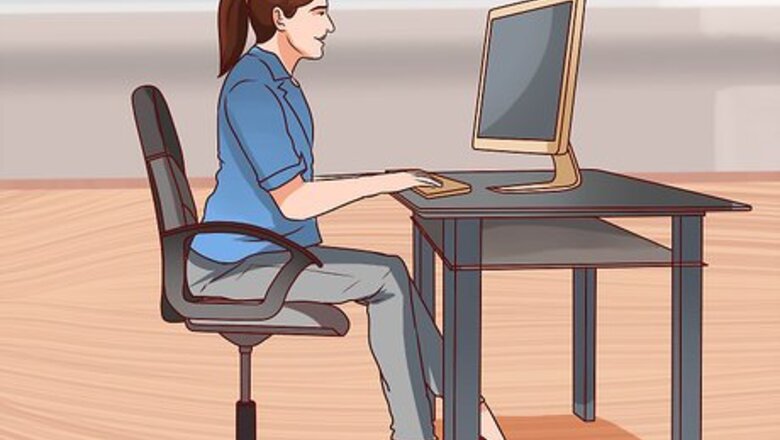
views
Adjusting an Office Chair
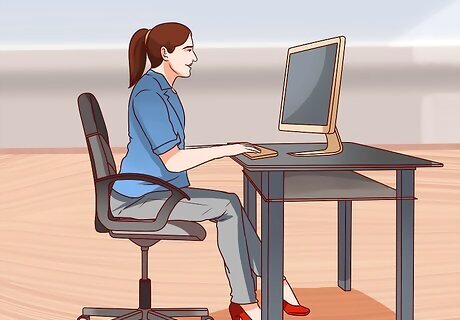
Establish the height of your workstation. Set up your workstation at the appropriate height. The most desirable situation is if you can change the height of your workstation but few workstations allow for this. If your workstation cannot be adjusted then you will have to adjust the height of your chair. If your workstation can be adjusted then stand in front of the chair and adjust the height so that the highest point is just below the kneecap. Then adjust your workstation height so that your elbows form a 90-degree angle when you are sitting with your hands resting on the desk top.
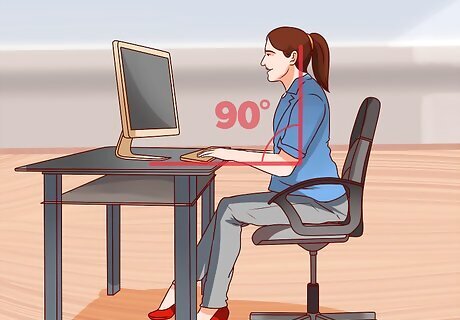
Assess the angle of your elbows with regard to the workstation. Sit as close to your desk as is comfortable with your upper arms parallel to your spine. Let your hands rest on the surface of the workstation or your computer keyboard, whichever you will use more often. They should be at a 90-degree angle. Sit on the chair in front of your workstation as closely as possible and feel under the seat of the chair for the height control. This is usually located on the left side. If your hands are higher than your elbows then the seat is too low. Raise your body off the seat and press the lever. This will allow the seat to rise. Once it's reached the desired height, let go of the lever to lock it into place. If the seat is too high, remain seated, press the lever, and let go when the desired height is reached.
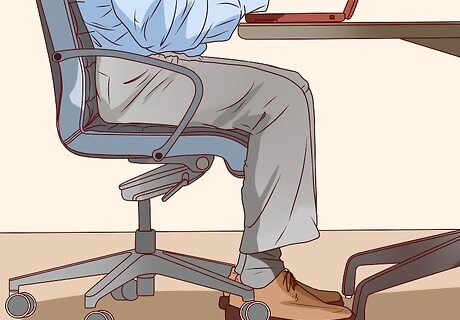
Make sure your feet are placed at the right level compared to your seat. While sitting down with your feet flat on the ground, slide your fingers between your thigh and the edge of the office chair. There should be about a finger’s width of space between your thigh and the office chair. If you're very tall and there's more than a finger's width between the chair and your thigh, you'll need to raise your office chair as well as your workstation to achieve the appropriate height. If it's difficult to slide your fingers under your thigh, you'll need to raise your feet to attain a 90-degree angle at your knees. You can use an adjustable footrest to create a higher surface for your feet to rest on.
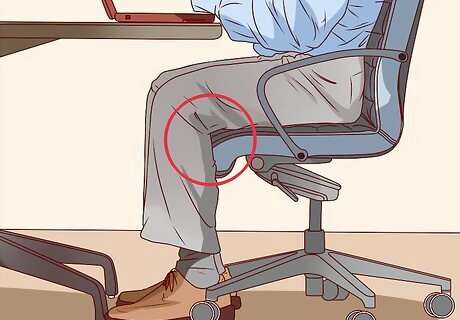
Measure the distance between your calf and the front of your office chair. Clench your fist and try to pass it between your office chair and the back of your calf. There should be a fist-sized space (about 5 cm or 2 inches) between your calf and the edge of the chair. This determines whether the depth of the chair is correct. If it's tight and difficult to fit your fist in the space, your chair is too deep and you'll need to bring the backrest forward. Most ergonomic office chairs allow you to do so by turning a lever below the seat on the right hand side. If you can't adjust the chair's depth, use a low back or lumbar support. If there is too much space between your calves and the edge of the chair then you can adjust the back backwards. There will usually be a lever below the seat on the right hand side. It's essential that the depth of your office chair is correct to avoid slumping or slouching while you work. Good lower back support will minimize the strain on your back and is a great precaution against low back injuries.
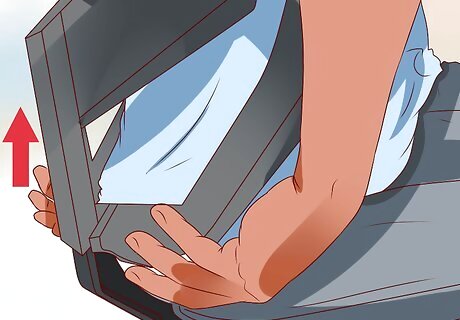
Adjust the height of the backrest. While sitting properly on the chair with your feet down and your calves a fist-space away from the edge of the chair move the backrest up or down to fit in the small of your back. This way it will provide the greatest support for your back. You want to feel firm support over the lumbar curve of your lower back. There should be a knob on the back of the chair allowing the backrest to move up and down. Since it is easier to lower the backrest than to raise it while sitting, start by raising it all the way up while standing. Then sit in the chair and adjust the backrest down until it fits in the small of your back. Not all chairs will allow you to adjust the height of the backrest.
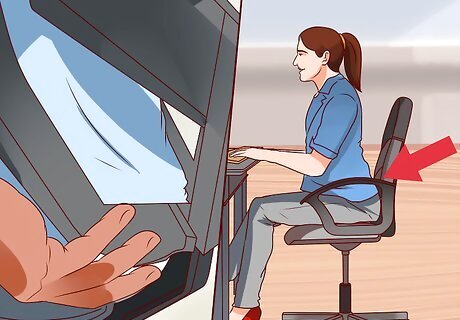
Adjust the angle of the backrest to fit your back. The backrest should be at an angle that supports you while sitting in your preferred posture. You should not have to lean back to feel it nor lean farther forward that you like to sit. There will be a knob locking the backrest angle in place on the back of the chair. Unlock the backrest angle and lean forwards and backwards while looking at your monitor. Once you reach the angle that feels right lock the backrest into place. Not all chairs will allow you to adjust the angle of the backrest.
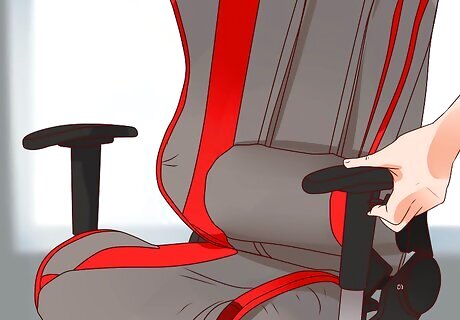
Adjust the armrests of the chair so that they barely touch your elbows when they are at a 90-degree angle. The armrests should just barely touch your elbows when resting your hands on the desk top or computer keyboard. If they are too high then they will force you to position your arms awkwardly. Your arms should be able to swing freely. Resting your arms on the armrests while typing will inhibit normal arm movement and cause extra strain on your fingers and supporting structures. Some chairs will require a screwdriver to adjust the armrests while others will have a knob that can be used to adjust the height of the armrests. Check on the lower portion of your armrests. Adjustable armrests are not available on all chairs. If your armrests are too high and cannot be adjusted then you should remove the armrests from the chair to prevent them from causing pain to your shoulders and fingers.
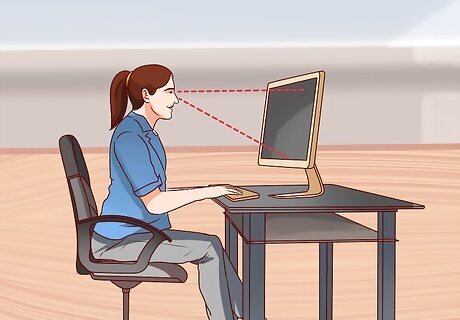
Assess your resting eye level. Your eyes should be level with the computer screen that you are working on. Assess this by sitting on the chair, closing your eyes, pointing your head directly forward and slowly opening them. You should be looking at the center of the computer screen and be able to read everything on it without straining your neck or moving your eyes up or down. If you have to move your eyes down to reach the computer screen then you can place something underneath it to raise its level. For example, you could slide a box under a monitor to raise it to the proper height. If you have to move your eyes up to reach the computer screen then you should try to find a way to lower the screen so that it is directly ahead of you.
Choosing the Correct Chair
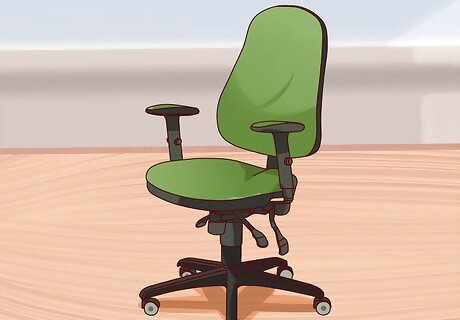
Choose the chair made for your body size. Most chairs are made to fit around 90 percent of people but those on the ends of the spectrum may not fit. Since there is no “average” person chairs are made in sizes that can be fully adjustable so that they can be made to fit most people. However, if you are very tall or very short then you may need a custom-made chair. Unless you get a custom-made chair, you should get a fully adjustable chair so that you can adjust it properly for your body.
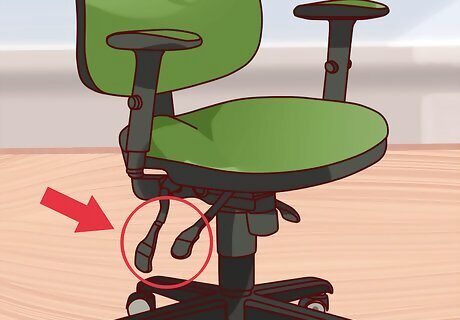
Choose a chair with controls that can be easily operated while sitting. Choosing a chair with controls that are easy to operate while sitting will allow you to adjust your chair completely to your body. You can put yourself in the chair and then adjust all the pieces directly onto your body.
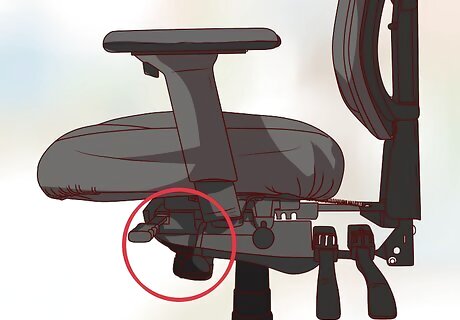
Choose a chair with a seat that can be adjusted for height and tilt. Height is a very important factor when adjusting a chair so it is very important that the height of the chair can be adjusted according to your body and needs. Tilt is also important for allowing correct posture while sitting.

Choose a comfortable seat that curves towards the floor at the front edge. The curve along the edge will provide more space for your knees and comfort on the backs of your thighs. Additionally, the seat should not put pressure on the back of thighs or knees.
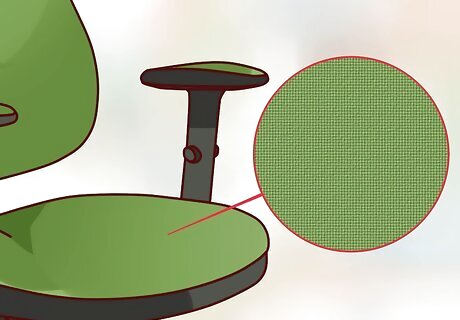
Choose a chair with breathable, non-slippery fabric. You don’t want to get all sweaty while working at your desk nor do you want to slide around too much so these factors are important when choosing a chair.
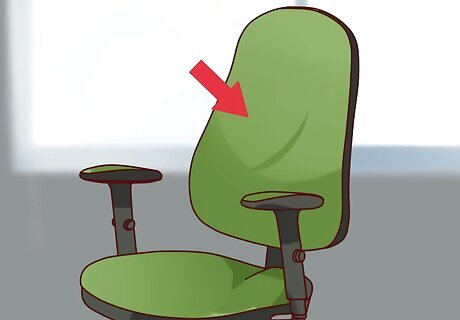
Choose a chair with a backrest that is shaped to support the lower back and adjustable in height and angle. Adjusting the backrest to completely support your lower back will allow you to remain pain and injury free.
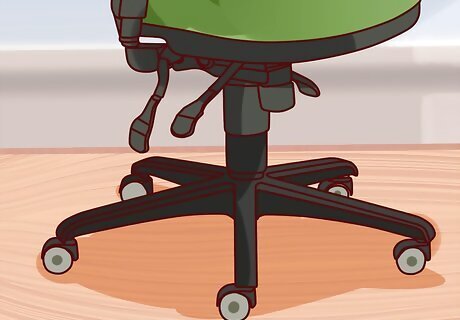
Choose a chair with a stable five-point base. The base should be a five-point system that provides balance and stability while sitting on the chair. The base should be on casters or wheels depending on your preferences.
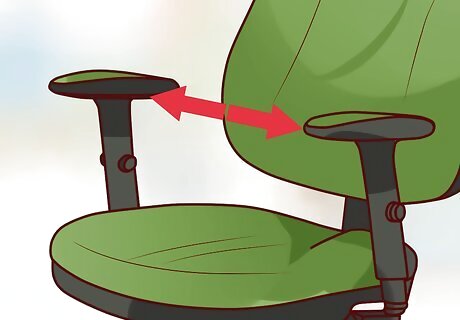
Choose a chair with armrests that are the right distance apart. You should be able to easily get in and out of the chair but the armrests should be as close as possible while sitting. The closer your elbows stay to your body while sitting, the more comfortable you will be.
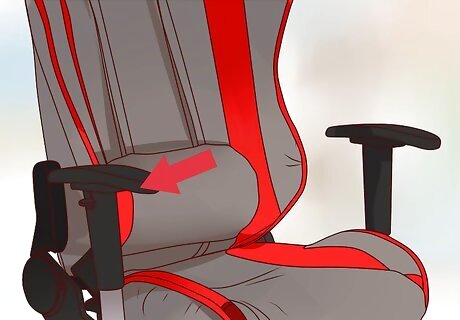
Choose a chair with adjustable armrests. Armrests should never hamper your movement while working or typing. Adjustable armrests will allow you to customize their height for your body size and arm length.


















Comments
0 comment